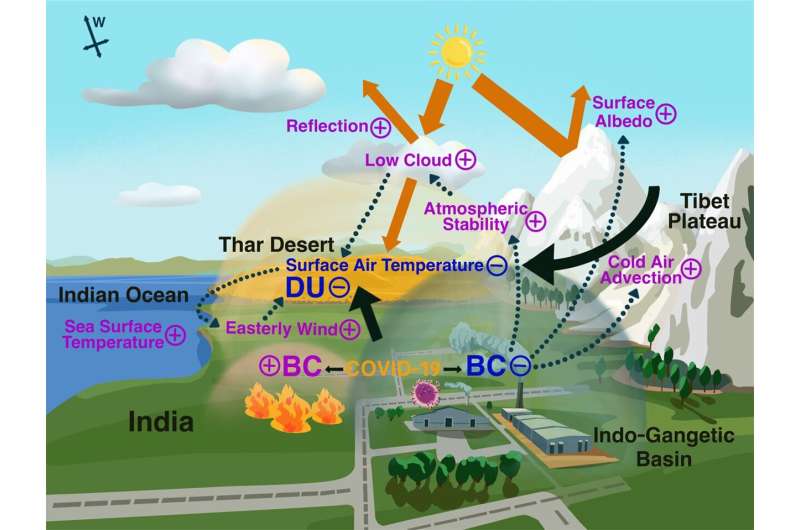Schematic interpreting the impacts of northern Indian BC reduction due to lockdown and southern Indian BC increase due to intensified crop residue burning during the Indian premonsoon season for the COVID-19 pandemic case. With the reductions of northern Indian BC and DU, the subsequent Indian summer monsoon outbreak is delayed. Note that the proposed mechanisms work not only for the COVID-19 case but also is valid in the long-term statistics. Credit: Nature Communications (2022). DOI: 10.1038/s41467-022-29468-1
Using atmospheric data collected in India during COVID-19 lockdowns in 2020, an international team of scientists has found that black carbon in India regulates dust loadings in the entire country. The researchers also found black carbon-dust-climate interactions caused the Indian summer monsoon season to start later than usual during the 2020 lockdown.
Black carbon in India modifies the atmospheric winds, which determines dust transport from the Middle East and the Sahara and local dust emissions, said Xiaohong Liu, professor in the Department of Atmospheric Sciences at Texas A&M University and a corresponding author of the research, recently published in Nature Communications.
"Black carbon, a type of aerosol from human activities, was dramatically reduced in northern India in April-May 2020 during COVID-19 lockdowns," Liu said. "Surprisingly, we found that dust, which is a natural aerosol, also reached a record low in India. By analyzing the atmospheric data, we found that the low dust level was caused by reduced atmospheric heating of black carbon during lockdowns, which induced the easterly wind anomalies, and thus reduced the dust transport from the Middle East and the Sahara. We found that aerosol-climate interactions delayed the outbreak of the subsequent Indian summer monsoon in 2020."
Zheng Lu, an associate research scientist in the Department of Atmospheric Sciences at Texas A&M, is also a co-first-author of this research.
"The precipitous reduction of air pollution during lockdowns provides a unique testbed for detecting the aerosol effects on weather and climate, by comparing satellite and ground-based observations of meteorological states during lockdowns against those in the historical polluted period," Liu said. "Our results of aerosol-climate interactions indicate co-benefits of future Indian aerosol-reduction for air quality, human health, and climate change."
India is a hotspot for air pollution and has heavy black carbon and dust levels, the researchers said. Atmospheric aerosols, such as black carbon and dust, can scatter and absorb incoming solar radiation, thus heating the atmosphere and cooling the surface. These changes can then further alter atmospheric circulation, temperatures and precipitation.
"Black carbon is a strong absorber of solar radiation. By heating the atmosphere, it can induce vertical motion of the atmosphere and change temperature vertical profile, thereby affecting atmospheric stability, cloud amount and atmospheric circulation," Liu said.
Aerosols in the Indian atmosphere include carbon produced locally from incomplete combustion of fuels, biomass-burning aerosols such as black carbon from crop residue burning, and natural dust both local from the Thar Desert and transported from remote deserts such as the Sahara and the Middle East.
The accumulation of dust and black carbon in northern India acts as a heat pump, Liu said, and can reinforce rainfall during the pre-monsoon and summer monsoon seasons. And, black carbon and dust deposits on snow over the Tibetan Plateau and the Himalayan region can accelerate snow melting. However, detecting the effects of black carbon and dust on the Indian climate remains challenging due to climate feedbacks and natural climate variability. The periods of COVID-19 lockdowns in India gave scientists a window into previously unseen scenarios of India's climate inputs.
More information: Linyi Wei et al, Black carbon-climate interactions regulate dust burdens over India revealed during COVID-19, Nature Communications (2022). DOI: 10.1038/s41467-022-29468-1
Journal information: Nature Communications
Provided by Texas A&M University
























